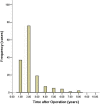Prediction of tumor recurrence after curative resection in gastric carcinoma based on bcl-2 expression
- PMID: 24555747
- PMCID: PMC3996074
- DOI: 10.1186/1477-7819-12-40
Prediction of tumor recurrence after curative resection in gastric carcinoma based on bcl-2 expression
Abstract
Background: There are currently no reliable predictive factors for gastric cancer recurrence. The aim of this study was to evaluate the relationship between bcl-2 expression and risk of gastric cancer recurrence.
Methods: From January 1996 to December 2007, 449 gastric cancer patients who underwent curative resection were retrospectively studied. The expression levels of bcl-2 were examined by immunohistochemistry. Logistic regression was performed to identify independent risk factors for overall recurrence of gastric cancer.
Results: 151 patients (33.6%) experienced recurrences. The median time to recurrence was 17.0 months, 113 (74.8%) patients had recurrences within 2 years. Peritoneal recurrence was the most prevalent pattern, followed by hematogenous metastasis in which the liver was the most common site. Depth of invasion, lymph node metastases, and negative expression of bcl-2 were independent risk factors for overall recurrence. The overall survival time of recurrent patients was 22.7 months. The median survival time after recurrence was 6.7 months.
Conclusion: The depth of invasion, lymph node metastases and expression of bcl-2 are independent factors for predicting gastric cancer recurrence.
Figures
Similar articles
-
Combined epithelial-mesenchymal transition with cancer stem cell-like marker as predictors of recurrence after radical resection for gastric cancer.World J Surg Oncol. 2014 Dec 2;12:368. doi: 10.1186/1477-7819-12-368. World J Surg Oncol. 2014. PMID: 25441488 Free PMC article.
-
Differences in risk factors between patterns of recurrence in patients after curative resection for advanced gastric carcinoma.World J Surg Oncol. 2013 May 17;11:98. doi: 10.1186/1477-7819-11-98. World J Surg Oncol. 2013. PMID: 23683476 Free PMC article.
-
The pattern and risk factors of recurrence of proximal gastric cancer after curative resection.J Surg Oncol. 2013 Feb;107(2):130-5. doi: 10.1002/jso.23252. Epub 2012 Sep 4. J Surg Oncol. 2013. PMID: 22949400
-
Prognostic Factors for Survival in Node-Negative Gastric Cancer Patients Who Underwent Curative Resection.Scand J Surg. 2017 Sep;106(3):235-240. doi: 10.1177/1457496916677878. Epub 2017 Apr 4. Scand J Surg. 2017. PMID: 28376652
-
Gastric neuroendocrine neoplasms type 1: A systematic review and meta-analysis.World J Gastroenterol. 2019 Sep 21;25(35):5376-5387. doi: 10.3748/wjg.v25.i35.5376. World J Gastroenterol. 2019. PMID: 31558880 Free PMC article.
Cited by
-
Bcl-2 and galectin-3 expression is associated with recurrence of ameloblastoma.Dent Res J (Isfahan). 2024 Dec 20;21:69. doi: 10.4103/drj.drj_706_23. eCollection 2024. Dent Res J (Isfahan). 2024. PMID: 39802810 Free PMC article.
-
Poorly Differentiated Medullary Phenotype Predicts Poor Survival in Early Lymph Node-Negative Gastro-Esophageal Adenocarcinomas.PLoS One. 2016 Dec 28;11(12):e0168237. doi: 10.1371/journal.pone.0168237. eCollection 2016. PLoS One. 2016. PMID: 28030564 Free PMC article.
-
How does epidemiological and clinicopathological features affect survival after gastrectomy for gastric cancer patients-single Egyptian center experience.World J Gastrointest Surg. 2016 Jun 27;8(6):444-51. doi: 10.4240/wjgs.v8.i6.444. World J Gastrointest Surg. 2016. PMID: 27358677 Free PMC article.
-
Combined epithelial-mesenchymal transition with cancer stem cell-like marker as predictors of recurrence after radical resection for gastric cancer.World J Surg Oncol. 2014 Dec 2;12:368. doi: 10.1186/1477-7819-12-368. World J Surg Oncol. 2014. PMID: 25441488 Free PMC article.
-
Gastric and gastroesophageal junction cancer: Risk factors and prophylactic treatments for prevention of peritoneal recurrence after curative intent surgery.Ann Gastroenterol Surg. 2022 Mar 24;6(4):474-485. doi: 10.1002/ags3.12565. eCollection 2022 Jul. Ann Gastroenterol Surg. 2022. PMID: 35847435 Free PMC article. Review.
References
-
- Shibata A, Parsonnet J. In: Cancer epidemiology and prevention. 3. Schottenfeld D, Fraumeni JF, editor. New York: Oxford University Press; 2006. Stomach cancer; pp. 707–720.
-
- Moriguchi S, Maehara Y, Korenaga D, Sugimachi K, Nose Y. Risk factors which predict pattern of recurrence after curative surgery for patients with advanced gastric cancer. SurgOncol. 1992;1:341–346. - PubMed
-
- Bohner H, Zimmer T, Hopfenmuller W, Berger G, Buhr HJ. Detection and prognosis of recurrent gastric cancer-is routine follow-up after gastrectomy worthwhile? Hepatogastroenterology. 2000;47:1489–1494. - PubMed
MeSH terms
Substances
LinkOut - more resources
Full Text Sources
Other Literature Sources
Medical




